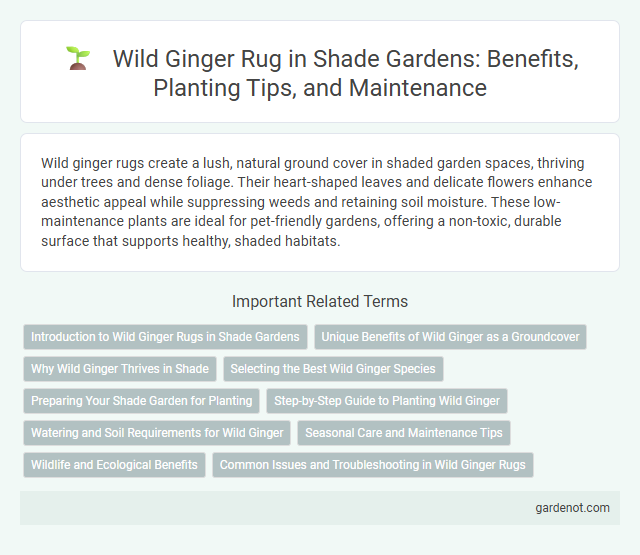Wild ginger rugs create a lush, natural ground cover in shaded garden spaces, thriving under trees and dense foliage. Their heart-shaped leaves and delicate flowers enhance aesthetic appeal while suppressing weeds and retaining soil moisture. These low-maintenance plants are ideal for pet-friendly gardens, offering a non-toxic, durable surface that supports healthy, shaded habitats.
Introduction to Wild Ginger Rugs in Shade Gardens
Wild ginger rugs thrive in the cool, shaded environments of shade gardens, offering a lush, evergreen ground cover that suppresses weeds and retains soil moisture. Their heart-shaped leaves create a dense carpet, enhancing garden aesthetics while supporting local wildlife by providing habitat and food sources. This low-maintenance plant adapts well to various soil types and requires minimal care, making it ideal for sustainable and eco-friendly gardening practices.
Unique Benefits of Wild Ginger as a Groundcover
Wild ginger (Asarum canadense) offers exceptional groundcover benefits in shade gardens due to its dense, evergreen foliage that suppresses weeds and conserves soil moisture. Its heart-shaped leaves create a lush, natural carpet while its low-growing habit protects delicate roots from temperature fluctuations. The plant also supports local biodiversity by providing habitat for beneficial insects and enhancing soil health through organic matter accumulation.
Why Wild Ginger Thrives in Shade
Wild ginger thrives in shade due to its natural adaptation to forest understories where sunlight is filtered and indirect. Its broad, heart-shaped leaves efficiently capture limited light, optimizing photosynthesis in low-light environments. The plant's preference for moist, well-drained soil combined with shade protection reduces water loss, promoting vigorous growth and a dense ground cover.
Selecting the Best Wild Ginger Species
Selecting the best wild ginger species for a shade garden depends on factors such as climate adaptability, growth habit, and aesthetic appeal. Asarum canadense, commonly known as Canadian wild ginger, thrives in USDA zones 3-8 and features heart-shaped leaves with a dense, low-growing habit ideal for ground cover. For a more ornamental option, Asarum europaeum offers glossy, dark green foliage and is suited to shaded, moist environments, enhancing the garden's texture and biodiversity.
Preparing Your Shade Garden for Planting
Wild ginger rug thrives in moist, well-drained soils rich in organic matter, making it ideal for shaded garden areas with dappled sunlight. Preparing your shade garden for planting involves clearing debris, loosening the soil to a depth of 6-8 inches, and incorporating ample compost to enhance fertility and moisture retention. Proper soil preparation ensures healthy root establishment and promotes the dense, lush groundcover that defines a successful wild ginger rug.
Step-by-Step Guide to Planting Wild Ginger
Wild ginger (Asarum canadense) thrives in shaded, moist environments with well-drained soil rich in organic matter. Begin planting by loosening soil and incorporating compost to enhance fertility, then place rhizomes about 2 inches deep and 6 to 12 inches apart to allow ample spreading. Water thoroughly after planting and maintain consistent moisture while the plant becomes established, ensuring a dense, natural wild ginger rug that suppresses weeds and enhances shade garden aesthetics.
Watering and Soil Requirements for Wild Ginger
Wild ginger (Asarum canadense) thrives in consistently moist, well-draining soil rich in organic matter, making it ideal for shaded garden areas with loamy or humus-rich substrates. Regular watering is essential to maintain soil moisture without waterlogging, especially during dry spells, ensuring the plant's roots remain healthy and vibrant. Avoid heavy clay soils or overly dry conditions, as these can stress the plant and inhibit its groundcover potential in shade gardens.
Seasonal Care and Maintenance Tips
Wild ginger rug thrives in shaded garden areas, requiring consistent moisture and well-drained soil to maintain lush growth throughout the year. In spring, apply a layer of organic mulch to conserve moisture and suppress weeds, while trimming dead foliage in late fall enhances plant health and appearance. Regular monitoring for pests such as slugs and snails helps prevent damage, ensuring a vibrant ground cover that complements shade gardens seasonally.
Wildlife and Ecological Benefits
Wild ginger rug creates a dense ground cover that provides essential habitat and shelter for small wildlife, including insects, amphibians, and ground-nesting birds. Its evergreen foliage supports soil stability and moisture retention, promoting a healthy micro-ecosystem within shade gardens. By attracting pollinators and supporting diverse invertebrate populations, wild ginger contributes significantly to local biodiversity and ecological resilience.
Common Issues and Troubleshooting in Wild Ginger Rugs
Wild ginger rugs often face issues such as yellowing leaves, which usually indicate insufficient moisture or poor soil drainage, requiring consistent watering and well-drained soil amendments. Pests like slugs and snails commonly damage foliage, and applying organic slug repellents or barriers can effectively mitigate these problems. To promote healthy growth, ensure the plant is shaded adequately, as excessive sunlight can cause leaf scorch and reduced vigor.
Wild ginger rug Infographic

 gardenot.com
gardenot.com